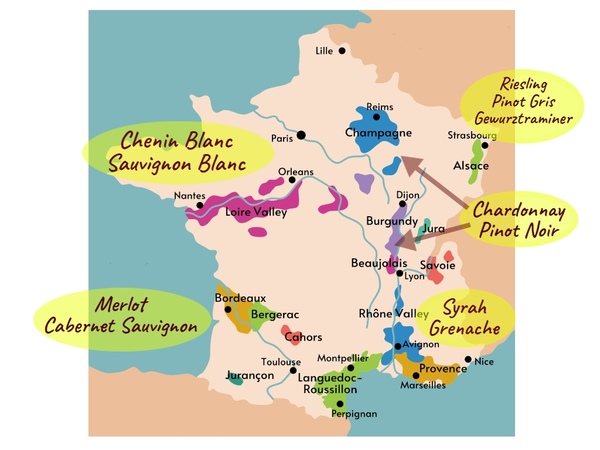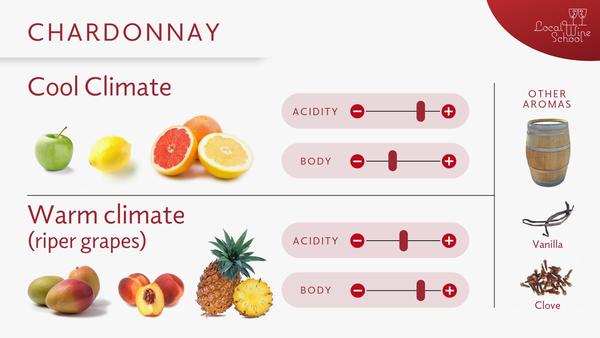
If you find yourself feeling a bit clueless about French wine labels, try this potted guide to grapes and regions.
At Cambridgeshire Wine School, we love helping you decode wine. If you want to learn more, consider our 8-part 'World of Wine' course.
The first step towards understanding French wine labels is to learn which grapes are grown and where.
The French have long used a system that 'claims' grapes for AOC wine made in certain regions. It means, for example, red Burgundy cannot be made from the same grapes as red Bordeaux.
Knowing which grape variety is behind a given label is the first step towards predicting the style and flavour of your French wine. Take a look at the wine map of France on this page - I have added the most prominent grapes used in each region.
Bordeaux
Let's focus on the red wines of Bordeaux (whites and rosés are also made, but the area is famous for its reds). The grapes are mainly either Cabernet Sauvignon with Merlot blended in, or the other way around (mainly Merlot with some Cabernet Franc and/or Cabernet Sauvignon blended in). There are some other minor grapes, but these are the main ones.
Cabernet Sauvignon and Cabernet Franc both make dark, tannic wines, while Merlot is also fairly dark but has softer tannins. Expect flavours of blackberry, blackcurrant, plum and spicy oak flavours from better wines with flavours of age (like earth) if older vintages. These red wines will be good with red meat, cheddar and other salty foods.
Burgundy
The polar opposite of Bordeaux, red wines from Burgundy are lighter, paler and taste of red fruit (cherry, raspberry, strawberry and cranberry). This is because the grape used is Pinot Noir, which has a thin skin, so tannins are low.
As a result, the red wines of Burgundy are just as good with white meats like chicken and fish as they are with red meats and stews.
White Burgundy is usually made from Chardonnay, and it may be oaked. This means you can expect some texture (body) in the wine, but the style varies from citrus and green apple flavours in cool-climate versions like Chablis to rich, peachy flavours in warmer Mâcon and Pouilly-Fuissé. There are many top-quality and quite famous white wines that are named after Burgundy's best villages (e.g. Mersault).
The Loire Valley
The Loire Valley is most famous for its white wines. The main grapes here are Chenin Blanc and Sauvignon Blanc.
Sauvignon Blanc tends to be zesty and a lot crisper than Chardonnay. It's a style we are most familiar with from New Zealand, but the French version is very lean. Wines like Sancerre and Pouilly-Fumé should have plenty of gooseberry and grapefruit, maybe grass and elderflower and are not usually oaked.
Chenin Blanc from this area can be quite lean, but there are peachy examples and some can be oaked. Chenin Blanc can also be made off-dry, medium or sweet. Think of Chenin's flavours as being a lot like the range of flavours that Chardonnay has, but with the option of sweetness left in the wine as well.
The Rhone Valley
This is Syrah and Grenache heartland (Syrah is the same grape as Shiraz). If you enjoy Australian Shiraz for its ripe flavours and spicy character, you might also enjoy Côtes du Rhône, Gigondas or Chateauneuf-du-Pape. These French wines I just mentioned are really blends of Grenache, Syrah and Mourvedre, but thanks to the warm climate of the Southern Rhone these are warm and spicy wines (like Shiraz, although not usually oaked).
Red wines from Northern Rhone with names like Hermitage, Côte-Rôtie or Crozes-Hermitage are made mainly from Syrah, but these will be leaner and more savoury than most Australian Shiraz. Very good examples can have interesting earthy and meaty flavours.
These red wines are good with barbecue food, stews and pork.
Alsace
This area next to Germany grows German-sounding grapes like Riesling and Gewurztraminer. Thanks to a range of mountains immediately to the east, the wines here are usually very fruity from all the sun the climate enjoys (the driest area in France). The Riesling tends to be dry, but Gewurztraminer is often medium sweet and Pinot Gris off-dry. If you haven't tried Gewurztraminer before, you should - it is very floral and smells of roses.
Book the 8-part 'World of Wine' course to find out more - it's flexible (if you need to skip a night, let me know, and we will credit you). It's a great way to tour the world of wine, find new favourite wines, ask questions and learn loads of useful stuff.




